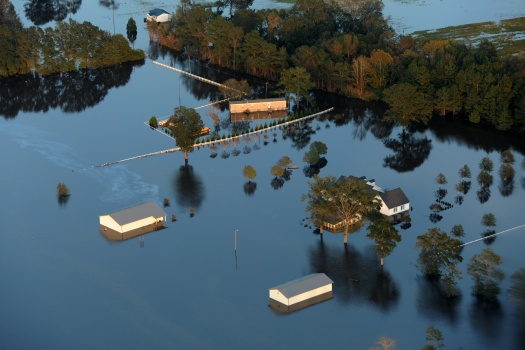Hurricane Matthew Illustrated the 5 Forms of Flooding

Credit: Eduardo Schneider
Flooding from Hurricane Matthew exceeded all expectations. Part of the problem is that flooding is described as if it were a single phenomenon when in actuality there are several types that can act as multipliers. In my work to help companies and communities prepare for future flooding, I segregate five fundamental forms of flooding and show how the effects can compound.
When you’re up to your nostrils in water, those distinctions don’t really matter. You just need to get to safety. But if we are to plan for future flooding and become more resilient, we need to intelligently address the 5 forms of flooding that have very different characteristics. The recent flooding from Hurricane Matthew included some component of all five forms, which I define as:
1. COASTAL WAVES AND STORM SURGE – The classic damage from severe weather systems hitting coastal areas. Huge waves can topple houses and breach shorelines, moving water inland. The surge can work its way further into waterways and bays, sometimes piling up even higher, causing even more flooding. All of this dissipates in hours, allowing recovery.
2. RECORD RAINFALL – Matthew brought vast amounts of rain all along its path from Haiti, through the Bahamas and to Florida mid-Coast, all the way up to the Carolina’s and beyond. Even aside from hurricanes, the warmer ocean will continue to evaporate more, with the added moisture necessarily coming back down as rain, or if the temperature is cold enough, as snow. That’s the reason we are getting more unprecedented rainfall, sometimes called “monsoon rains” as has been seen in the last few months from Texas to West Virginia and as far as Asia and Europe. (For more, see blog about recent Maryland floods https://johnenglander.net/wp/Ellicott-City-Floods
3. RUNOFF – Excess rainfall moves downhill, often adding to streams and rivers, which can overflow their banks, even far from the area of the initial flooding. This effect can be delayed by days from the actual storm and rainfall. As soils become saturated, the runoff can dramatically increase. Much of the recent flooding in North Carolina many days after Matthew resulted from such runoff.
4. EXTREME HIGH TIDES – often known as ‘King Tides’ are the ultra high tides that go well above the normal daily high-water mark. Most know that the up and down tides occur almost twice daily, progressing a little later each day following the gravitational attraction of the moon. At the new moon and full moon following the 28 day lunar cycle, high tide reaches a monthly peak, due to the alignment of the sun and moon. When the moon is closest to the Earth in October each year, the tides are even higher, reaching an annual high. (This tidal pattern actually follows a slight variation over an 18.6 year orbital pattern.) In recent years, coastal communities from Miami to Manila and from Boston to Bangladesh have noticed that the King Tides reach higher and occur on more days than they did previously. The pull of the moon has not changed. It is the ‘fifth factor’ — rising sea level — that has raised the base level for the entire tide cycle, manifesting as increased King Tides.
5. RISING SEA LEVEL – Rising sea level is different than all the above flood factors. It is much slower in speed, perhaps only fractions of an inch per year. But it just keeps getting higher and higher and will not go down for centuries. It is the “stealth flooding” that cannot be seen directly, but that shows up as it raises all the other flooding. Though global average sea level only increased about ten inches over the last century, the rate of sea level rise is now accelerating and could be a foot or two higher by mid-century. Rising sea level comes from a few distinct causes. Over the past century, most of the rise has come from the expansion of seawater, due to it being about 1.5 degrees F (one degree C) warmer. In recent decades and for the coming centuries, it will be the melting of glaciers and ice sheets on land, from Alaska to Greenland and Antarctica that causes the accelerating rise. In certain regions and locations, the global sea level change may be increased or offset by effects such as vertical land movement (subsidence or uplift.) For example, New Orleans has had 46 inches since 1880, where Los Angeles has had only 4 inches, with the difference being vertical land movement.
To forecast future flooding, these five flood factors need to be looked at separately. Each of them have different impact areas, magnitudes, causes, predictability, and timescales to occur and to recede. To use a metaphor, if we are sick, it is inadequate just to say we have an illness. A more specific description of a virus, a bacterial infection, cancer, or a kidney problem conveys far more meaning and indicates the kind of treatment that is required. The same with flooding. If we all start identifying which of the five forms of flooding an event is, it will educate everyone concerned with the different problems, causes, and options. Wave damage might be thwarted by a seawall. Rainfall and downstream runoff might be reduced by a system of levees and culverts to divert the water. Rising sea level might warrant floating structures, elevating structures, or possibly planned retreat.
Flooding is extremely serious, even deadly, as we have seen all too often. The “5th Factor”, rising sea level is the one that is the hardest to observe and yet will cause the most long-term destruction. Unfortunately sea level rise has passed a tipping point and is now unstoppable for centuries. We can see it amplifying the other four factors, but it needs to be understood and tracked for what it is — the stealth flooding factor that creeps higher at all locations touching the ocean globally; the one that is moving higher and accelerating, will not recede, and requires a different response. We need to start using a vocabulary that distinguishes all five forms of flooding and how they interrelate, so we can begin to better plan and adapt to live in a world with increased flood risk.

